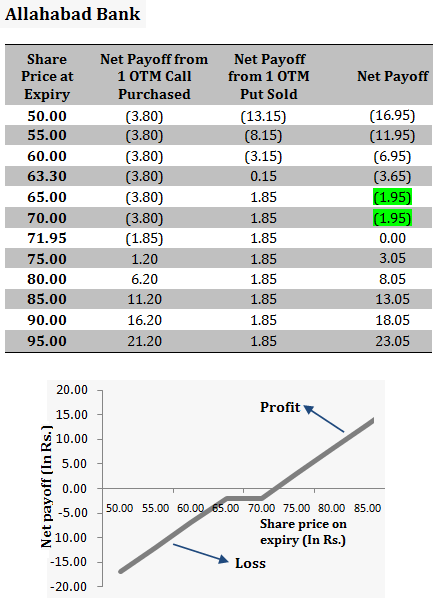When to use: When you are Bullish and anticipate the stock / index to rise.
How it works: Long Combo Option Strategy uses two option contracts with the same expiry date but different strike prices. In this strategy, you sell/write 1 out-of-the-money put option; and buy 1 out-of-the-money call option, each with the same expiry date, T.
Suppose, you are bullish on Allahabad Bank stock on 4th September 2013, when the share trades at Rs. 66.65. You sell/write an out-of-the-money put option at a premium at a premium of Rs. 1.85, expiring 26th September 2013 with a strike price of Rs. 65 and buy an out-of-the-money call option at a premium of Rs. 3.80, with a strike price of Rs. 70.
(click to enlarge)
Risk/Reward: In long combo option strategy, the risk is unlimited and the maximum reward/profit is also unlimited.
For Call Option: If the price of Allahabad Bank rises above Rs. 70.00 (i.e. the strike price), you can exercise your option, but the price of the stock must rise above Rs. 73.80 (i.e. the strike price + the amount of premium paid) for you to exercise your option and make a profit.
For Put Option: If the price of the share stays above Rs. 65.00 (i.e. the strike price) until expiry, you will retain the entire premium amount (i.e. Rs. 1.85). If however the price falls below Rs. 65.00, the buyer of put option may exercise his option. Once the price falls below Rs. 63.15 (i.e. the strike price – premium), the buyer of put option will start making a profit based on how far below Rs. 65.00 does the stock price fall. From the perspective of the seller of the put (you), you will start suffering a loss once the stock price falls below Rs. 63.15 (i.e. the strike price – premium).
The table below shows the net payoff of long combo option strategy at different spot prices on the expiry date:
How to use the Long Combo Option Strategy Excel calculator
Just enter your expected spot price on expiry, option strike price and the amount of premium, to estimate your net pay-off from the long combo option strategy.
Note: The example and calculations are based assuming a single share though in reality options are based on lots of many shares. For example Allahabad Bank option contract is for 2,000 shares. Accordingly the net premium paid will be Rs. 3,900 for 2 lots (i.e. 1.95 *2,000) in our example.
Also Note: Unlike the buyer of an option who only pays the premium to buy the option, the seller of an option must deposit a margin amount with the exchange. This is because he takes an unlimited risk as the stock price may rise to any level. In case the price rises sharply above the strike price, the exchange utilises the margin amount to make good the profit which the option buyer makes. The amount of margin is decided by the exchange and it typically ranges from 15 % to 60 % based on the volatility in the underlying stock and market conditions. In the above example, as a seller of put option, you will have to deposit a margin of Rs. 21,502 (i.e. Strike price * Lot size * 16.54%) for selling/writing a lot of Allahabad Bank put option. Note that the total value of your outstanding position in this case will be Rs. 1,30,000 (i.e. strike price * lot size).



